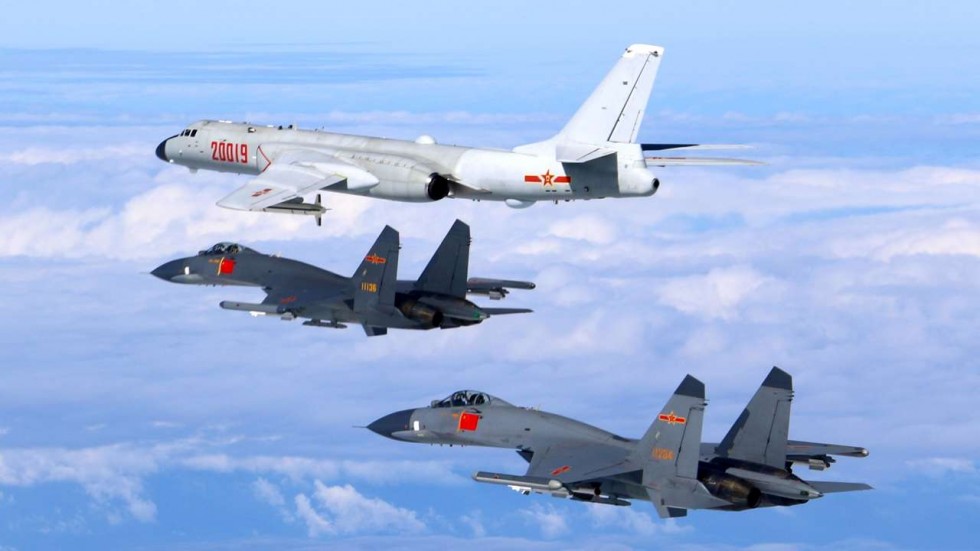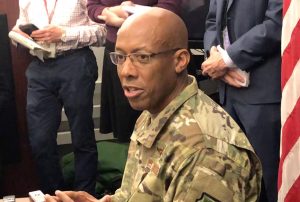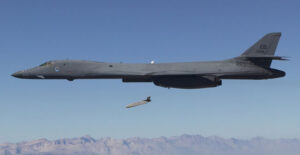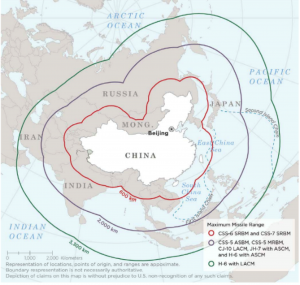Chinese Pilots ‘Safe & Professional’ – For Now: PACAF
Posted on
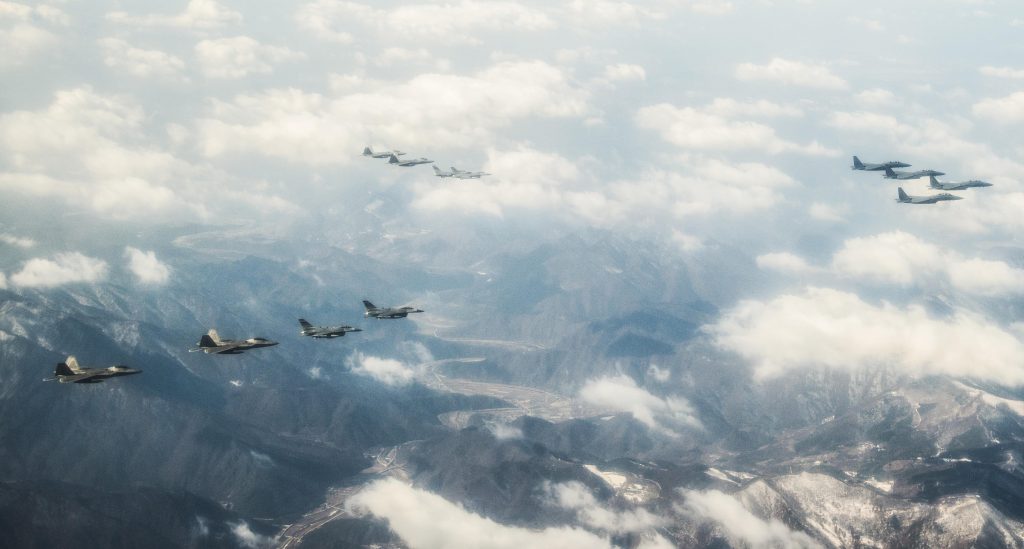
US Air Force F-22 Raptors arrive at Osan Air Base, South Korea in 2016, escorted by US F-16s and Korean F-15s.
PENTAGON: Despite some alarming incidents at sea, Chinese forces have refrained from “provocative” behavior towards US aircraft, the commander of Pacific Air Forces (PACAF) said today. But while China has shown no intent to take hostile action, its capability to do so is real, Gen. C.Q. Brown told reporters in a Pentagon briefing, and the air units he commands are working hard on new tactics, technologies, and concepts to counter “our pacing threat… China.”
That includes everything from fielding new weapons like the F-35 stealth fighter and the Long-Range Anti-Ship Missile (LRASM), to adding more space-operations planners to theater staffs, to reemphasizing that old-fashioned initiative so junior commanders can act when an enemy cuts off their communications with higher headquarters.
“By and large… safe and professional”
For now, China’s behavior in the air is pretty normal — or at least what passes for normal in what the National Defense Strategy calls an era of “strategic competition” between great powers.
Brown took over PACAF in July. “In the four months I’ve been in the job, I’ve seen very few intercepts of our bomber missions. There’s been intercepts of some of our intelligence aircraft,” he said. “It’s sporadic, it’s not every time we fly,” he said in a press briefing.
One reporter asked if there have been any Chinese intercepts of US aircraft you’d characterize as unsafe? “Not necessarily,” Brown said. “There are some we could characterize maybe as unprofessional, a little more aggressive than others, but… I see the same thing, having served in Europe, with the Russians, (and in this job) with the Russians up around Alaska, because that’s also part of my AOR (Area of Responsibility).”
“It kind of ebbs and flows, but by and large, they’ve been safe and professional,” Brown said. “I haven’t seen, at least from an air perspective, an increase in tensions.”
That’s a relief, particularly because the worst US-China crisis in a generation was triggered by an unsafe intercept back in 2001. That’s when a Chinese fighter collided with a US Navy EP-3 reconnaissance plane off the sensitive naval bases on Hainan Island, killing the Chinese pilot, forcing the American plane — full of classified material and technology — down on Chinese soil, and leading China to detain the 24 US crew for 11 days. That incident was soon overshadowed by the 9/11 attacks and two decades of guerrilla warfare in the Muslim world, but China’s increasing assertiveness in the Pacific and American pushback make a repeat all too possible if either side should slip up.
The difference today: While the Chinese military is better-trained and more professional, making accidents like 2001’s less likely, it’s also more assertive, higher-tech, and capable of reaching much farther beyond mainland China. The head of Indo-Pacific Command, Adm. Phil Davidson, has said that by creating and then fortifying artificial islands in the disputed South China Sea, China has created a “Great Wall of SAMs” (Surface-to-Air-Missiles).
In peacetime, this new Great Wall doesn’t stop US aircraft, Gen. Brown said. “Now, we can fly there,” he said. “If we’re going to conflict, it’s a whole different story than just flying through there on a day to day basis.”
Brown likened the South China Sea to Syria, where he oversaw operations in his last job as Air Force component commander for Central Command. “(There are) pretty capable SAM systems in Syria, but there wasn’t intent to use those against the coalition,” he said. “I would say the same thing in this case, for right now, in the South China Sea.”
“But if the tensions go up, then we’re going to defend ourselves,” he said. “We have the inherent right of self-defense and will do what we need to.”
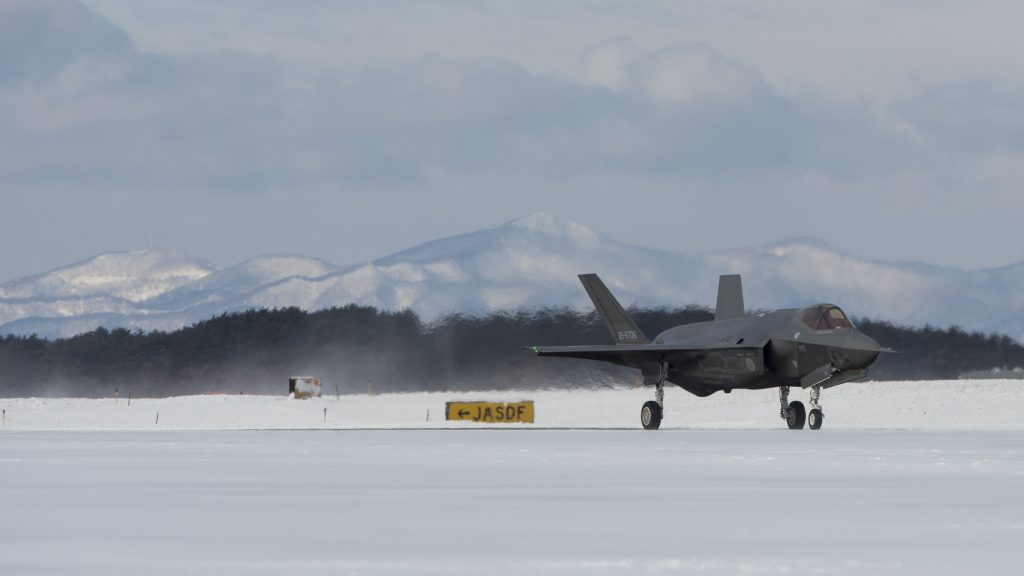
The Japan Air Self Defense-Force’s first operational F-35A Joint Strike Fighter arrived at Misawa Air Base on Jan. 26, 2018
“Our Pacing Threat”
Preparing for a possible conflict with China drives much of what the US military does worldwide. In Pacific Air Forces particularly, that requires thinking about how to operate outside the post-Cold War comfort zone where US airpower, satellites, and communications networks could act at will without significant interference.
“When we look at our pacing threat of China, we’ve got to think different,” Gen. Brown said. That requires “new operational concepts, thinking outside the box a little more, really challenging my staff” — and yes, “it’s going to take some money.”
The most tangible change is new equipment, with the US fielding its most advanced technology to the Pacific before anywhere else. That includes major deployments of stealth fighters — both the F-22 Raptor and the brand-new F-35A Joint Strike Fighter — which are specifically designed to evade, penetrate, and destroy advanced anti-aircraft defenses like “Great Wall of SAMs” that China has erected on artificial islands in the South China Sea.
It also includes new long-range missiles to let non-stealthy aircraft, like the B-52 and B-1 bombers, strike from outside the range of such air defenses, specifically the JASSM-ER and its ship-killing cousin, the LRASM. The anti-ship missile in particular hasn’t yet achieved Initial Operational Capability (IOC) firing from the B-1, Brown said, but it’s an important priority in the short term. In the longer run, he said, he’s very interested in the hypersonic weapons the Pentagon is developing.
Less visible changes are occurring in space, which is quietly crucial for everything from surveillance to communications to weather forecasting. “This is an area I’m actually learning a lot more about,” Brown said. “Space has been something that’s very, very classified, so we didn’t even talk to ourselves about some of this… Now that we’re able to talk at a lower classification level, (that) helps to raise awareness of both our capabilities but also the threat.” (Not that he said this aloud, but China is the only nation to use a weapon to destroy a satellite since the 1980s).
Both the head of Air Force Space Command, Gen. Jay Raymond, and his superior, Strategic Command’s Gen. John Hyten, will be visiting Gen. Brown next week at his Pacific Air Forces HQ in Hawaii. The commanders have pledged to work more closely with the theater commanders who cover the planet’s surface and will probably be providing more space experts to Indo-Pacific Command’s planning staff, Brown said.
Indeed, some of the most important changes are less about new wonder weapons than about how human minds plan and train. Brown is reviewing long-standing exercises, both US-only and international, to see how to push them to the “next level” of challenge, he said.
One initiative he’s working on: rapid redeployment across the vastness of the Pacific. The idea is that America’s allies can count on US forces responding when needed but America’s adversaries can’t predict how or where — what Defense Secretary Jim Mattis’s National Defense Strategy calls being “strategically predictable, but operationally unpredictable.”
Just deploying to an exercise, for example, is currently a “major muscle movement” that monopolizes both the units concerned and their supporting transport for a long time, Brown said: “How do we move small packages around pretty quickly to complicate things for our adversary?”
Another high priority: teaching a generation of officers used to email, satellite phones, and constant contact to take the initiative if an enemy hacks, jams, or physically destroys those communications systems.
“How do we operate in a contested environment, because I can’t guarantee that my coms will be up the entire time?” Brown asked. Commanders, he said, need to give their subordinates enough clarity ahead of time about the objectives and how to achieve them — what’s called “commander’s intent” — that they can confidently pursue those objectives on their own, even when communications fail — what’s often called “mission command.”
“Don’t wait for direction,” Brown said. “Go execute with mission-type orders.”
Subscribe to our newsletter
Promotions, new products and sales. Directly to your inbox.

